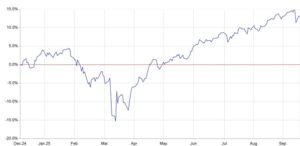
As we head into the final quarter of 2025, the remarkable recent performance of global equity markets continues at pace. Following the sharp fall immediately after the initial announcement of trade tariffs by President Trump in April, global indices have rallied strongly since, with the S&P500 index of leading US companies rallying by over 30% over the last six months.

S&P500 index 31/12/2024 to 14/10/2025, priced in US Dollars – source F E Analytics
Investor confidence has so far been unwavering, with any dip in markets seen as a buying opportunity. Other assets, such as Gold – often considered a haven in troubled times – have also seen strong demand. Stocks involved in the development of Artificial Intelligence (AI) have seen prices rise sharply over recent months, as investors anticipate strong earnings growth over future years.
You could view the continued exuberance as being a signal that all is well with the global economy; however, dark clouds continue to build from a range of factors, which investors appear content to ignore. In short, we feel markets run the risk of achieving “peak complacency.”
Ignoring the risks
Tariffs imposed by the US on other nations, which led to the sharp pullback earlier in the year, may return to dominate headlines over coming months, as many questions surrounding tariffs remain unanswered, not least the fact that the US has yet to reach a trade deal with China, Canada and Mexico, which are their three largest trading partners. The recent spat between Presidents Trump and Xi, which led to Trump suggesting an additional 100% tariff rate would apply to Chinese goods from 1st November, acts as a timely reminder that tariff-induced volatility may return.
The imposition of tariffs to date are certainly not helping the hard-pressed US consumer. Price increases on everyday essentials are hurting middle America, leaving less money available for discretionary expenditure. This may well serve to keep inflation higher than the Federal Reserve would like and limit the potential for further interest rate cuts that the market expects to see.
The US jobs market also continues to weaken, hardly a ringing endorsement of a strong economy. The current US Government shutdown has led to a void in key economic data, and this may also be masking the true picture of this key measure.
It is fair to say that US corporate earnings remain strong and as we head into the third quarter earnings season, we would expect to see most major players reporting data that matches expectations. The concern is that the rapid price increase seen in the technology sector over recent months leaves valuations exposed to disappointment.
Another key concern are Government debt levels, considering the hike in borrowing costs for both France and the UK. Whilst falling back from the peak seen last month, the yield on long dated UK Government debt remains elevated and bond markets will be closely watching the forthcoming Budget to see whether Chancellor Rachel Reeves can calm fears that debt levels will rise further.
Finally, despite the recent positive developments in the Middle East, geopolitical risk will remain a constant concern. Any escalation in the conflict between Russia and Ukraine, or a ramping up of the threat level against Taiwan, would increase market risk substantially.
What comes next?
Sentiment drives global markets, and positive market momentum can be a powerful force, fuelled by investor psychology. It is, therefore, entirely possible that markets continue to drift higher over the remainder of this year and into 2026; however, seasoned fund managers are becoming concerned that stock valuations, particularly in AI, may be heading towards “bubble” territory.
Whilst the long-term outlook remains positive, we feel that the risks of a period of higher volatility have increased. This may, therefore, be a sensible time to review your existing investments and consider whether the mix of assets you hold is appropriate for your needs and objectives. Ensuring that your portfolio holds a range of diversified assets has been of lesser importance over recent months when stock values have rallied strongly; however, in more turbulent times, spreading assets across other classes such as fixed interest securities, or increasing the allocation to cash, may provide shelter.
Speak to one of our experienced financial planners if you would like us to take an impartial review of your existing investment portfolio. We can help identify areas where you may be over-exposed to a particular region or sector and provide advice on how best to rebalance your pension or investment portfolio.





